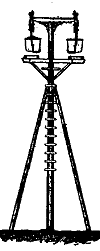Part of a series of articles titled Chilkoot Tramways.
Article
Chilkoot Tramways and the Peterson Hoist
On the White Pass Trail, pack horses and pack mules could carry up to 250 pounds of supplies. Six to seven horses or mules could make up a pack train. For a fee, drivers would take your supplies to the lakes. However, on the Chilkoot Trail, it was too steep after Sheep Camp to use pack animals. To compete against the White Pass pack trains, plans were made for construction of tramways on the Chilkoot. These would transport the stampeders' outfits and supplies over Chilkoot Pass at reasonable rates.
By late April 1898 several tramways were in operation up Chilkoot Pass. Two of the tramways are significant engineering feats. One tramway crossed a distance of 2,200 feet in one span, then the world's longest. Another was one of the first aerial tramways powered by electricity. These tramways and hoists were important final links to make the Chilkoot Trail the dominant route to the interior. However, they failed to compete with the White Pass & Yukon Route railroad. Most of the Chilkoot transportation companies were bought out by the Skagway-based railroad.

NPS image
The Peterson Hoist
P. H. Peterson, a ferry operator from Juneau, installed a simple hoist at the Scales before the main rush occurred. Stampeder William M. Stanley describes the operation:
[Peterson] anchors a pulley at the top through which he passes a rope, to which is attached a box, rigged on runners. A loaded sled is made fast to the rope at the bottom; the box is then filled with snow, to which is added the weight of the inventor and such other men as may be at hand. When this loaded box descends it pulls the sled up, where it is detached. The box is then unloaded and drawn back to the top when the operation is repeated as before.
In 1894, Peterson had previously attempted to do the same operation with sealskins instead of a box with runners but it failed. He returned in 1896 with the gravity hoist described above. According to a sourdough known only as "Silvertip," Peterson charged four bits a load. On February 17, 1898, he leased his tram to J. F. Hielscher of Dyea for five months, the peak months of the rush. He received a half-cent royalty on each pound carried by the operation.
The exact location of the Peterson tram is unknown. He may, in fact, have operated on the nearby Peterson Pass (which was named after him) instead of the Chilkoot Pass. There are many artifacts in the vicinity of the pass but because of its simplicity, it is difficult, if not impossible to identify the exact line or pulley Peterson used.1
Written by Frank Norris, edited by Karl Gurcke.
1.The discussion on the Peterson hoist is taken directly from Spude, Chilkoot Trail, pp. 195-197.
Last updated: October 26, 2021
